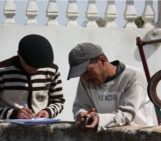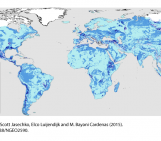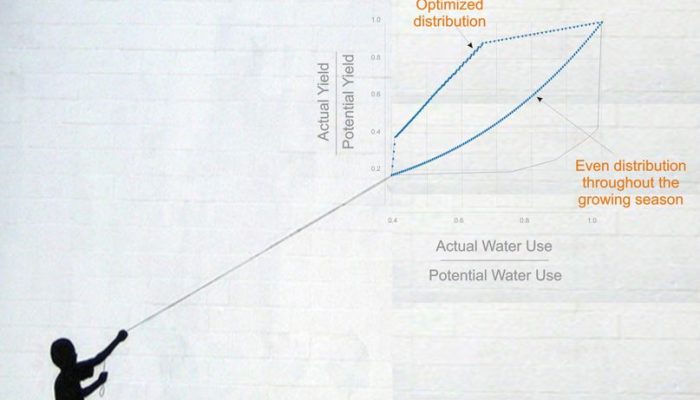
Post by WaterUnderground contributor Mikhail Smilovic. Mikhail is a PhD candidate in the Department of Civil Engineering at McGill University, in Quebec.
Crops use water for photosynthesis, absorbing nutrients, and transpiration, or the plant-equivalent of sweating. A crop may experience water-stress if the soil surrounding the roots is not adequately wet, and this stress will affect the crop differently depending on the crop’s stage of growth. Irrigation is the watering of plants to ultimately avoid such water-stress.
Non-irrigated crops are more vulnerable to intervals of dry and hot weather, and the increasing unpredictability of a changing climate will further complicate other crop management tools, such as choosing different cultivars (the particular variety of crop, some which may deal with certain stresses in an improved way) or changing planting dates.
Irrigated crops do not experience water stress (they may in fact experience water stress under a non-perfect irrigation system, but forgive this for now), but the water is necessarily derived from somewhere else. This somewhere else may also experience water withdrawals from municipalities, industry, and other agriculture. The source of water may be underground, or water from a river, lake, or spring, but a connection between both underground and surface waters shares with us that water removed from a system somewhere will have a response somewhere. This somewhere may very well be an ecosystem. Irrigation may also be costly related to the abstraction, transportation, and on-farm distribution.
Between non-irrigated and irrigated is a curious place where we can increase the resiliency of our agricultural systems to periods of drought and heat with limited irrigation, while allowing crops to experience well-timed water stress. Agricultural productivity or yield is determined as the amount of crop produced per area of land, say 3 tons/hectare for wheat. When water is a limiting factor, we would be sensible to also consider water productivity, that is the ratio of crop yield and water use, or, the amount of crop produced per drop of water. The practices of limited irrigation, also known as supplemental or deficit irrigation, makes an effort to increase this water productivity.
This space in-between non-irrigated and irrigated, however, has been often poorly explored or simplified. Crop kites is a novel tool to determine and quantify the potential agricultural and water productivity associated with different irrigation practices. This is important for regions interested in shifting investments into or away from irrigation, as well as for researchers interested in evaluating limited irrigation practices as initiatives to establish food and water security, both currently and with changing climates.
A first thought might be, if a crop uses three quarters of the water than it would under ideal conditions, does the crop produce three quarters as much as the crop under ideal conditions? In fact, the answer depends very much on when this water is used.
Let us take the example of winter wheat in northern Africa. Winter wheat can be broadly characterized into five different growth stages. We can illustrate water use throughout the season with the following figure:
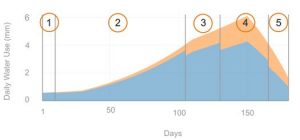
Water use is represented by the bottom blue colour, and the associated deficit is represented with the upper orange colour – the top line of the shape is the amount of water the crop would use under ideal conditions on the associated day. This example shows a 0, 10, 20, 30, and 40% deficit occurring in stages 1 to 5 respectively, representing a 78% water use across the entire growing season as compared to ideal conditions. Understanding both the amount of water used and when the water was used, we are able to determine the associated yield, for this example, we reach 68% of potential yield.
Now, what if we were to simulate the yield using all reasonable water uses and all reasonable distributions of the timing of this water use? The resulting shape is our crop kite, with each point associated with a water use distributed throughout the growing season in a particular way:
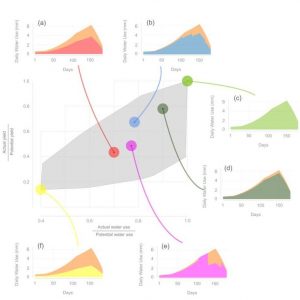
This shape illustrates the incredible range of yields associated with each water use; for example, 80% of potential water use relates to between ~20 and 90% of potential crop yield.
Water distributed through canals are often delivered according to a schedule, and not necessarily related to growth-stage sensitivities or actual weather. From the crop kite we can derive estimates on how the crop yield will be affected by adopting certain irrigation schedules. We elaborate on this with three examples: S1) water use is distributed to optimize yield, S2) the deficit is distributed evenly across all growth stages, S3) water is used preferentially for the earlier growth stages. The resulting crop-water production functions are illustrated in the following figure:
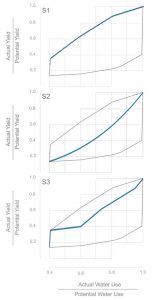
Although the first schedule optimizing for crop yield may be in line with the motivations of the irrigating farmer, it is often an unreasonable assumption for farmers delivered water according to predetermined schedules, but may be appropriate for farmers irrigating with a privately owned well. Evaluating the potential of supplemental irrigation necessitates estimating the ability of farmers to manage both the amount and timing of irrigation applications. Otherwise, non-reasonable assumptions may be used to evaluate and over promise estimates for agricultural production, with the fault not in the practice of limited irrigation, but in the criteria used to evaluate the system.
Crop kites demonstrate the wide range of water use-crop yield relationships, and can be used to evaluate the potential of limited irrigation to shift both food and water security.

Mikhail Smilovic is a PhD candidate at McGill University and the University of Victoria . Mikhail’s work investigates the interplay between foot security, water resources, and energy, and evaluating and integrating initiatives that increase agricultural production while reducing demands on water resources.

